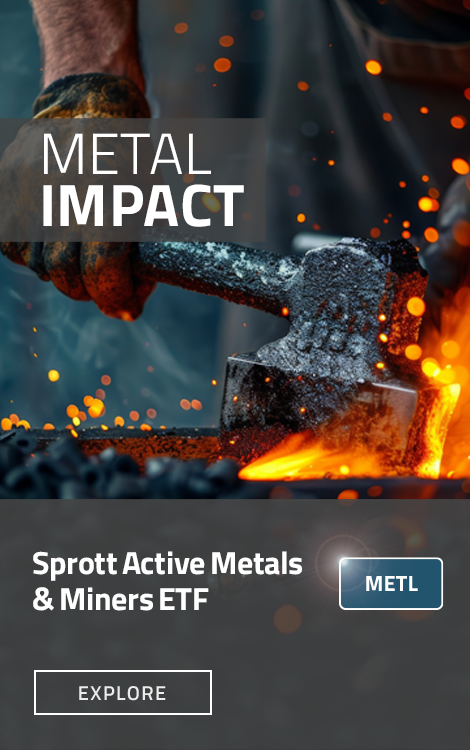Since this writing, copper LME prices hit a new all-time high above $11,000 per metric ton.
Key Takeaways
-
Copper Breaks Out: Copper topped $10,000/ metric ton in September amid major supply shocks; miners surged, led by juniors up 72.46% YTD.
-
Global Supply Strained: Mine disruptions from Grasberg to Kamoa-Kakula deepened the supply deficit, making 2025 the weakest year of supply growth since 2011.
-
U.S. Policy Boosts Miners: Washington’s equity stake in Trilogy Metals and its push for critical minerals have fueled triple-digit gains for U.S. junior copper miners.
-
Billion-Dollar M&A Wave: The $53 billion Anglo-Teck merger highlights copper’s dominance as major mining companies pivot away from coal.
-
Copper’s New Era: Decoupling from oil and iron ore, copper remains a top play on energy transition and supply security.
Performance as of September 30, 2025
Average Annual Total Returns*
| Indicator | 1 MO* | 3 MO* | YTD* | 1 YR | 3 YR | 5 YR |
| U.S. Copper Price (LME SPOT)1 | 4.11% | 1.74% | 18.18% | 5.50% | 10.00% | 8.93% |
| Copper Mining Equities (Nasdaq Sprott Copper Miners Index TR)2 | 16.27% | 23.19% | 38.26% | 11.48% | 30.37% | 22.47% |
| Copper Junior Mining Equities (Nasdaq Sprott Junior Copper Miners Index TR)3 | 16.65% | 30.20% | 72.46% | 50.85% | 38.09% | N/A |
| Broad Commodities (BCOM Index)4 | 1.79% | 2.56% | 5.94% | 4.27% | -2.09% | 8.10% |
| U.S. Equities (S&P 500 TR Index)5 | 3.65% | 8.12% | 14.83% | 17.60% | 24.91% | 16.46% |
*Performance for periods of less than one year is not annualized.
Source: Bloomberg as of 09/30/2025. You cannot invest directly in an index. Past performance is no guarantee of future results.
Performance Overview: Copper Breaks Out
Copper surged decisively in September, breaking through the $10,000 per metric ton threshold and closing the month with a gain of 4.11%.1 This move marked the highest copper spot price in over a year (since May 2024), with the price ending the month at $4.64 per lb. Copper miners capitalized on copper prices rapidly nearing their all-time highs with an impressive 16.27% gain.2 Year-to-date, copper is up 18.18%, copper miners have gained 38.26% and junior copper miners3 have led the sector with a remarkable 72.46% advance.
Copper charged higher in September, on the back of supply shocks and surging investor demand for critical minerals.
Copper’s price action in September was shaped by a confluence of supply-side shocks and macroeconomic developments. The most significant catalyst was the shutdown of Freeport-McMoRan's Grasberg mine, the world’s second-largest copper mine (located in Indonesia). This event alone is expected to remove 591,000 metric tons of production from the market between now and December 2026, thereby accelerating the market’s transition into a significant supply deficit.6 This supply deficit has been years in the making, catalyzed by a steady stream of disruptions that have left the market structurally tight.
On the demand side, copper prices were buoyed by the trend toward dedollarization. The Federal Reserve’s 25 basis points rate cut, and signals of further easing added to the momentum. The U.S. government shutdown and the Supreme Court’s review of the legality of tariffs also added complexity to the market. Investor flows into commodities accelerated as tangible assets gained favor, with critical minerals emerging as the clear beneficiaries. Growing recognition of their strategic importance for energy security and technological advancement amplified interest in copper, reinforcing its role as an enabler of tomorrow’s energy, defense and technology ecosystems.
Government strategy continued to favor U.S.-focused juniors, with the administration’s equity stake in Trilogy Metals acting as a means for outsized gains. This move reinforced investor confidence that concrete steps will be taken to bolster domestic supply chains and drove copper miners higher.
Looking at longer-term performance, copper and copper miners have meaningfully outpaced equities and broader commodity benchmarks, respectively, over the past five years (see Figure 1).
Figure 1. Physical Copper and Copper Stocks Have Outperformed Other Asset Classes Over the Past Five Years (9/30/2020-9/30/2025)
Source: Bloomberg and Sprott Asset Management. Data as of 09/30/2025. Copper Miners are measured by the Nasdaq Sprott Copper Miners™ Index (NSCOPPT index); U.S. Equities are measured by the S&P 500 TR Index; the Copper Spot Price is measured by LMCADY Comdty; and Commodities are measured by the Bloomberg Commodity Index (BCOM). Definitions of the indices are provided in the footnotes. You cannot invest directly in an index. Included for illustrative purposes only. Past performance is no guarantee of future results.
Market Drivers
Supply Disruptions Fueled the Copper Deficit
The scale of the September shutdown of the Grasberg copper mine was extraordinary, with lost output through December 2026 exceeding the entire annual production of Collahuasi (jointly owned by Anglo American plc, Glencore and Japan Collahuasi Resources B.V.), the world’s third-largest copper mine (see Figure 2). Grasberg experienced an enormous 800,000 metric tons of mud rushing into the mine. Q4 2025 sales from Grasberg are expected to be “insignificant,” and Freeport has notified counterparties of force majeure, amplifying the supply crunch and forcing market participants to recalibrate expectations.7
This disruption adds to the numerous setbacks across the industry of late:
- The Kamoa-Kakula copper complex (a joint venture between Ivanhoe Mines, Zijin Mining Group and the Democratic Republic of Congo), the fifth largest copper mine in the world, faces sizeable output cuts following flooding this summer (estimated to be down ~300 thousand metric tons).8
- Teck Resources Inc. revised its production guidance downward (by ~60,000 metric tons) for multiple operations, including its flagship Chilean mine, citing operational reviews and ongoing challenges.9
- Codelco’s El Teniente mine, the tenth largest in the world, revised down production by 33 thousand metric tons after an accident.10
- The late 2023 shutdown of First Quantum’s Cobre Panama mine continues after the Panama government ordered it to be shut down (a loss of over 300 thousand metric tons).
This chain reaction of copper production disruptions has further strained global supply and heightened market sensitivity to new developments. In response, several major mining companies are racing to boost production. BHP’s October 1 announcement that it will invest $840 million in Olympic Dam is a clear signal of urgency, but new supply continues to lag behind demand.11 Notably, 2025 is shaping up to be the weakest year for mined copper growth since 2011, reinforcing the narrative of structural tightness in the market.
Grasberg led a wave of copper mine disruptions that deepened the supply crisis and supported price momentum.
With primary copper supply under pressure, scrap copper is being increasingly called upon to fill the gap. However, technical limitations mean scrap cannot fully offset the deficit. Although Type 1 copper scrap is usable, lower-quality scrap requires additional refining and capacity constraints persist. Years of limited investment in new copper projects and frequent supply disruptions have steadily tightened the market, setting the stage for the current copper bull market. As a result, any additional disruption, whether from operational setbacks, geopolitical events or policy changes, has the potential to drive significant price action and reshape market expectations.
Reflecting the severity of copper’s supply challenges, major investment banks such as Bank of America and Goldman Sachs have announced increased copper price targets, citing reduced supply forecasts and the heightened risk of further disruptions.12
Figure 2. Top Five Copper Mines 2024 Production and Disruptions in Metric Tons
Source: S&P Global Market Intelligence and company announcements.
U.S. Government Buying Equity Stakes in Miners
September saw U.S. policy momentum drive triple-digit gains for some copper miners, with the Trump administration taking a direct equity stake in Trilogy Metals (TMQ) and issuing an executive order permitting the construction of the Ambler Access Road in Alaska.13 This dual move, valued at $35.6 million for a 10% equity position plus warrants, resulted in TMQ shares tripling in value on the news. The Ambler Access Road, a long-contested infrastructure project, is designed to unlock vast critical mineral deposits in Alaska, further reinforcing the U.S. government’s commitment to domestic resource security.
These actions are part of a broader pattern of direct U.S. investments in the critical minerals sector, including:
- Thacker Pass (Lithium Americas, LAC):
The administration secured an equity stake tied to renegotiating the Department of Energy (DOE) loan for the Thacker Pass lithium project in Nevada.14 The announcement nearly doubled LAC’s share price in a single day and lifted lithium miners broadly. - Mountain Pass (MP Materials, MP):
The U.S. Department of Defense became the largest shareholder via a $400 million preferred equity package.15 The deal included a price floor commitment for rare earths, set well above current spot prices and a guarantee that 100% of magnet production at MP’s 10X Facility will be purchased by defense and commercial customers, with shared upside.
The U.S. is taking equity stakes that are shaping the critical minerals landscape.
Taken together, these policy moves signal a decisive shift in which the U.S. government is not only recognizing the strategic importance of critical minerals but also actively shaping the sector through direct investment, infrastructure support, permitting reform and long-term purchasing commitments. For copper miners, especially U.S.-focused juniors, the implications are profound. Accelerated permitting, streamlined regulatory hurdles and increased likelihood of future production milestones are now a greater reality.
As global competition for critical minerals intensifies, U.S. policy actions are setting the benchmark for investment, innovation and supply chain resilience. The sector’s transformation is being shaped not only by market forces but by government priorities that recognize copper’s essential role in energy, defense and technology.
Merger & Acquisition (M&A) Activity: Billion-Dollar Bets on Copper’s Critical Future
September saw copper sector consolidation accelerate, with Anglo American and Teck Resources’ proposed merger to form the world’s sixth-largest copper producer (see Figure 3) and could ramp up to make the world’s largest copper mine.16 This deal, valued at $53 billion, is part of a broader wave of high-premium acquisitions as major miners pivot toward copper, the largest and most liquid of the critical minerals.
Major Copper Transactions and Premiums Paid:
- Anglo American-Teck Resources merger (2025):
- Combined market value: $53 billion
- Premium paid: 17% over Teck’s last close
- Lundin acquisition of Filo Mining (2024)17:
- Deal value: C$4.1 billion (US$3.0 billion) for 100% of Filo shares not already owned
- Premium paid: 32.2% over Filo’s 30-day VWAP prior to announcement
- BHP takeover of Oz Minerals (2023)18:
- Deal value: AUD$9.6 billion (US$6.8 billion)
- Premium paid: 49.3% over Oz Minerals’ closing price prior to the initial bid
- Rio Tinto acquisition of Turquoise Hill (2022)19:
-
- Deal value: $3.3 billion for the remaining 49% stake
- Premium paid: 67% over Turquoise Hill’s closing price prior to the initial proposal
Teck Resources made headlines by announcing a substantial spin-off of its coal business, a decisive move to sharpen its focus on copper. This strategic pivot reflects the company’s recognition of copper’s outsized role in the future of global industry, as demand for critical minerals accelerates and legacy commodities like coal lose demand. Teck’s recent moves are positioning it to capitalize on long-term growth and policy tailwinds driving the copper sector.
Copper stands apart as a leading critical mineral driving global mining strategy.
Anglo American demonstrated the strategic value of its copper portfolio by successfully fending off a takeover bid from BHP, the world’s largest copper producer, whose interest was driven by Anglo’s coveted copper assets. In the wake of this defense, Anglo American spun off its platinum group metals (PGM) business as Valterra Platinum and sold its coal and nickel operations. These moves underscore a broader industry trend among major miners to streamline their portfolios and concentrate on copper.
Copper stands apart as the largest and most liquid critical mineral, making it the natural focal point for major miners seeking to reposition their portfolios. Unlike iron ore and coal, which have historically relied on China and now face declining demand, copper is uniquely positioned to benefit from a convergence of global priorities, such as energy security, defense modernization and the rapid advancement of technology. As governments and industries intensify their focus on securing critical mineral supply chains, copper’s scale and versatility make it a leading candidate for investment, consolidation and strategic growth. This shift is reshaping capital flows across the sector, with major miners and investors alike recognizing copper’s outsized role in the next era of industrial and policy-driven transformation.
The strategic importance of copper has never been clearer. Its scale, liquidity and versatility make it the premier target for investment and consolidation, setting it apart from other minerals and reinforcing its status as the likely metal of choice for major miners seeking future-facing growth. We believe this may continue to provide a tailwind for both large and small pure-play copper miners.
Figure 3. Anglo-Teck to Become Sixth Largest Copper Miner
Source: S&P Global Market Intelligence. Data shown is for 2024.
Looking Ahead
As the copper market enters the final months of 2025, the landscape is defined by deepening supply deficits, evolving policy priorities and industry consolidation. The recent disruptions, most notably the extended shutdown at Grasberg, have pushed the market further into deficit territory, with refined copper shortfalls projected to intensify through 2026. Years of underinvestment and recurring supply interruptions have left inventories low, amplifying the market’s sensitivity to new shocks. Mined supply growth is on track for its weakest year since 2011, and while scrap copper is increasingly relied upon to plug the gap, technical limitations mean it cannot fully offset primary supply shortfalls. Any further disruptions could drive significant price action and reshape market expectations.
We believe copper’s rising strategic importance and deepening deficit may support its next powerful bull run.
Policy support for domestic mining and critical minerals in the U.S. remains a powerful tailwind, with further interest rate cuts anticipated before year-end and ongoing debates around tariffs and infrastructure approvals adding complexity to the macroeconomic backdrop. These decisions will remain key catalysts for sector performance, as governments and industries intensify their focus on securing critical mineral supply chains. We believe the recent M&A activity is likely to continue, with majors and juniors alike seeking exposure to copper’s strategic growth potential. As legacy commodities like iron ore and oil remain soft, copper stands out as the premier target for capital and consolidation. Notably, copper has decoupled from oil and iron ore, reflecting its weakening reliance on China (see Figure 4). This ongoing shift positions copper as one of the key building blocks for nations and industries.
Copper’s unique position at the intersection of energy infrastructure, defense systems and technological advancement, combined with its market size, is driving investor flows and policy attention. Copper’s evolving role as a foundational material for modern innovation continues to reinforce its status as the likely metal of choice for future-facing growth.
Figure 4. Copper Has Diverged from Iron Ore and Oil
Source: Bloomberg as of 09/30/2025. Copper is measured by LMCADY Comdty. Iron Ore is measured by the ISIX62IU Index. Oil is measured by CO1 Comdty (Brent Crude Oil).
Footnotes
Investment Risks and Important Disclosure
A bull market is a period when stock prices are rising or expected to rise, often driven by investor confidence and strong economic performance.
Relative to other sectors, precious metals and natural resources investments have higher headline risk and are more sensitive to changes in economic data, political or regulatory events, and underlying commodity price fluctuations. Risks related to extraction, storage and liquidity should also be considered.
Gold and precious metals are referred to with terms of art like "store of value," "safe haven" and "safe asset." These terms should not be construed to guarantee any form of investment safety. While “safe” assets like gold, Treasuries, money market funds and cash generally do not carry a high risk of loss relative to other asset classes, any asset may lose value, which may involve the complete loss of invested principal.
Past performance is no guarantee of future results. You cannot invest directly in an index. Investments, commentary and opinions are unique and may not be reflective of any other Sprott entity or affiliate. Forward-looking language should not be construed as predictive. While third-party sources are believed to be reliable, Sprott makes no guarantee as to their accuracy or timeliness. This information does not constitute an offer or solicitation and may not be relied upon or considered to be the rendering of tax, legal, accounting or professional advice.








